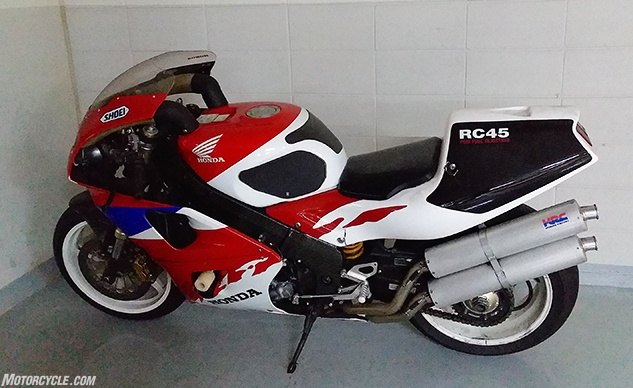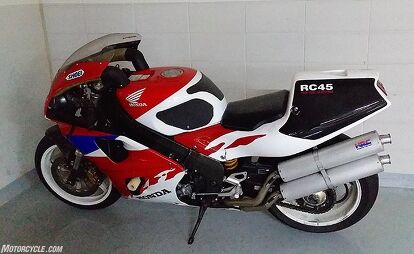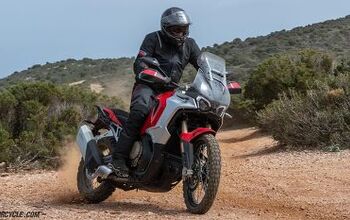Seoul Survivor: How an International Coalition Helped Me Import Half of South Korea's Honda RC45 Supply
With a lot of help from my friends
My greatest fear was of not taking the chance, of wimping out, of being that half-drunk guy at the bar, many years in the future, mumbling about the special whine of straight-cut gear-driven overhead cams, or staring at the floor in embarrassment, unable to pronounce “homologation” on the third try. Everyone who’s ever had a dream bike can tell you a story about it; most of them end with the words, “I wish I had it back.”
I’d owned a Honda NC35 RVF400, my heretofore ultimate, during a stay in South Korea five years previous; I’d spent eight years there as a visiting professor of English and literature. I loved that NC35, and I missed the linear delivery and low, sit-inside feel of a mid-’90s Honda V4 sportbike. The void in my life left by its untimely crank/main bearing suicide remains.
That is why I am here, standing next to a repossessed Honda RC45 RVF750 in a public parking garage in Seoul, South Korea, while my good friend Hwang Young Sung argues with a loan shark in Korean. This is the 1994 RC45, a bike raced by the likes of Joey Dunlop, John Kocinski, Miguel Duhamel and Colin Edwards, a bike so rare and valuable, Keanu Reeves felt justified taking a six-minute selfie with one and posting the video to Youtube.
The owner of this example, however, does not ride; he has never ridden the bike. His predecessor spent a lot of money on the bike and took good care of it, but was a little crazy, and made bad decisions elsewhere. There are no manuals or maintenance records. The missing stock parts are gone for good. Young Sung points to highlight small flaws. Silence follows. The guys pretend to be interested in their phones. They won’t even look at each other.
Worst case scenario, I am going to get this motorcycle for less than the price of the enduro bike I’ve been eyeing for next summer, but these guys are giving each other the cold shoulder over less than $200. I know that Young Sung has my best interests in mind and that he is just trying to get me the best deal possible, but is $200 really worth the risk?
I walk over to the owner, point at the motorcycle, say “my bike” with a big smile, shake his hand and give him a hug, though this probably isn’t the most culturally sensitive behavior when dealing with a sullen Korean loan shark. Sorry, can’t leave any room for doubt. We load the bike into Young Sung’s rusty shop truck, I use my wonderful sister-in-law’s account information to transfer the money, (a story in itself), and we get the bill of sale notarized. Everything is pretty easy, and soon we are on the highway south of Seoul, giggling like geeks. It’s a known fact that there are only two RC45s in South Korea. Young Sung owns one, and now I own the other. More or less…
The popular story is that there were only 200 RC45s made for homologation purposes in 1994, but that isn’t right. There were more, including spares sent to race teams and a second run of Japanese domestic models. How many more? Don’t know. Don’t care. It doesn’t matter at this point.
What matters, and what has kept me awake for over 50 hours, since I first learned of this bike’s existence and the idea that I might be able to buy it, is documenting its 11-digit JDM vehicle identification number and build date. Because the bike is titled as a 1998, the year of import into Korea, what am I supposed to do? Rent a storage locker for four years until it turns 25 to appease U.S. customs? I have contacted everyone: RC45 forums, various English motorcycle club certification services, American Honda Customer Service, the Vintage Japanese Motorcycle Club in the U.S., even the director of the AMA Motorcycle Hall of Fame Museum, without luck.
But then, about 3 am on the morning before I was to look at the bike, I received a PM on Facebook from a guy with a contact at Honda of South Africa: “This particular V.I.N. shows as a 1995 RVF750RS Ross White (NH196K) and was built for the Japanese Domestic Market. Engine serial number should be RC45E-1100017. Hope this helps! Built on 11-1-1994.”
Yes, it helped very much, but could he provide me contact information for his source? No. Could he help me find a way to get this in writing from Honda? No. Any suggestions for a next step? No, and good luck. Well, the details sounded authoritative, and it would be a heck of a mean joke to play on someone, probably good enough to call the risk “acceptable.”
So now I only have to store it for eight months. Maybe that is doable. Unbelievably, rain has the audacity to fall on my new RC45 as we pull into the auto and fabrication shop in Nonsan where my friend Patrick Miles, 25% of Korea’s classic bike community, has his shipping container shop. This is where Patrick keeps his RG400, CBR250RR, TZR250 and various other project bikes, and roughly where we will keep my new bike, but exactly where, we are not yet sure, as there is not a lot of room to spare in the shipping container.
Very carefully, we untie the clothesline and unload the bike as the rain increases to a steady drizzle, and another question that is not really a question presents itself. Heck yes, I am going to ride this thing before leaving the country! If I’m destined to mumble over beers to disinterested strangers about mythical bikes, darn straight I will do it as a guy who rode an RC45, once, for a few minutes, in the rain without a helmet on a frontage road in rural South Korea. So I do, very carefully over the gravel bits, and the bike feels good, even tempered and predictable, like the sport bike equivalent of a black lab or golden retriever, and I honestly feel as if I could take a sighting lap and then immediately drop into a grid position on it.
After some very tense moments, my wife and I manage to transfer the title at a rural DMV using my five-year-expired Korean visa, and then I am on a plane, separated (from bike, not wife), back in the U.S. Patrick’s garage landlord, Lee Kwan Hyun, probably the best tube-chassis drift car engineer in Korea, and an additional 25% of the Korean classic bike community, offers to store the bike in his shop and look after it for me, free of charge. An hour-long call to Honda Customer Service in Japan and the eventual connection to a saint of a man I will forever know only as “Mr. Takiamai,” produces the necessary build date documentation letter. I find a tailpiece for a CBR400F (yes, it’s a real bike), in Japan and buy it through Buyee.com as a thank you gift for Lee Kwan Hyun, but when Buyee.com tries to switch the $35 quoted shipping price to an extortion of $613.70 because the tail’s “size exceeds maximum limit,” a gentleman named Peter Uchikawa steps up and offers to take care of the shipping for me, at cost.
Meanwhile, an Ebay seller in Slovenia gives me a shipping discount on some vintage Colin Edwards posters, and Shea at the Texas Tornado Boot Camp offers to get Colin to inscribe them to Young Sung as a gift. Tim at Moto2 Imports gives me some guidance, advice, and moral support over the phone. I finalize shipping arrangements with what will prove to be the world’s most indifferent and incompetent logistics company. Eight months pass…
Young Sung not only delivers the bike to the port at Mokpo, but goes so far to send photos of his loaded truck at the port entrance, the shipping label on the crate, himself in front of the forklift as it transfers the bike, and even the crate as it is secured on the ship in which it will make the journey to Philadelphia, the Morning Caroline.
The next month passes very, very slowly as I track the ship’s progress to America. Finally, my logistics company sends notification that the bike has cleared customs in Philadelphia. Hours later, expectant that I will see my dream bike in two or three days at most, my agent calls to say that overland shipping might be delayed around the holidays. I hang up and receive a revised email saying that, in fact, the bike has not really cleared customs.
In the end, it takes 28 days for my crated motorcycle to traverse the final 509 miles of its 7,300 mile journey. The morning of its arrival, I am operating on 20-plus hours sans sleep after working all night in a paper mill. My father and some friends help me uncrate the bike, we choke down some cheap champagne purchased for the occasion and I stumble through an afternoon assessing the situation.
No doubt, the foreclosed owner had a systematic approach. It was to throw darts at a poster of an RC45 and then apply wads of cash to the impacted areas. Master cylinders are Brembo, shock is Öhlins, frame is covered with the nicest carbon fiber/resin laminate I have ever seen. A Dynojet quickshifter has been installed for that extra edge in bumper-to-bumper Seoul traffic. A lightweight lithium battery is mounted for the same application.
At least the Marchesini magnesium wheels, wrong!, incorporate a 17-inch front – a nice touch, really, that I appreciate instead of the 16-inch the RC came with. Fluids are clean. There is not the slightest drip or seep to be found, anywhere. Wiring harness is unkempt, but not cut. Valves are quiet. Shifting is smooth. Bodywork is salvageable. A symphony of straight-cut gear-driven overhead cams emanates from my garage. Work begins; existential angst looms.
So now what? I’ve got a restoration project worth the low market value of five kidneys, and I won’t even be able to race it when I’m done. But I’m not going to be that guy mumbling disconsolate bullshit over his beer, either. Like many, I develop irrational sentimental attachments to fast mechanical objects. Sounds and smells bring back memories, and every time I ride this bike, I’m going to think about the friends and family that helped me make a dream that never should have happened, happen.
At Vintage Motorcycle Days at Mid-Ohio in the late 1990s, there was a crowd of us around a Honda RC166 250cc six, and I distinctly remember a guy behind me saying, for everyone to hear, “It’s too valuable, no one is going to start that thing and actually ride it,” just before a bearded old character emerged from the crowd and took off at a jog to push-start it. To this day, that is the loudest bike I have ever heard, Manx Norton and TZ750 included, and it was beautiful.
That’s the guy I want to be. My brother is going to do the lunchtime laps at VMD this summer [assuming Vintage Motorcycle Days is still on – Ed.]. I hope he rides it hard enough to get the giggles. The bike will be in front of garage eight with a scrapbook on it. Check it out. Take a photo of the kids on it. Say hello. I’ll be the slow guy racing a Moriwaki that loves to share the story.
More by John Evans









































Comments
Join the conversation
Great story.
I love good story! thanks!